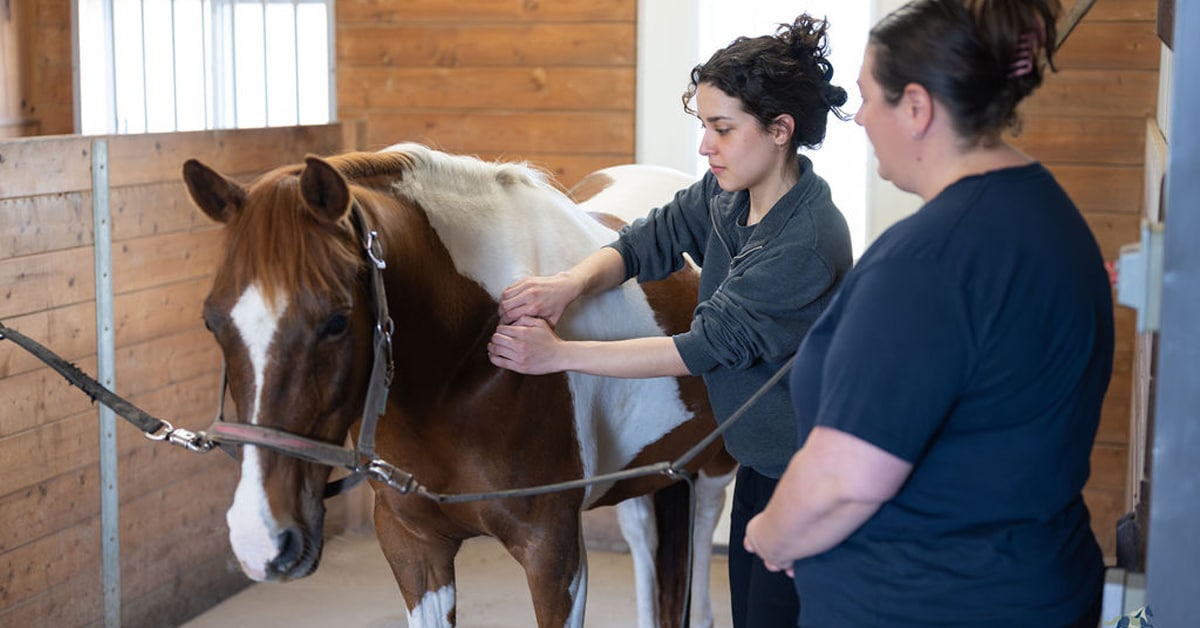Almost every equestrian has at some point watched a horse trot up and down, trying to determine if they’re sore and if so, in which leg. While in the past horse owners and vets have had to rely heavily on visual assessment, some technology out of Missouri has produced a device that can detect even the most subtle lameness.
The Equinosis Q with Lameness Locator is a handheld device whose readings are based on motion analysis research. Non-invasive, inertial sensors are attached to the horse that are ten times more sensitive than the human eye and as the horse is trotted in a straight line and lunged on a circle, the sensors can pick up on asymmetries in the gait that may otherwise be otherwise missed. This makes it a valuable tool for veterinarians to assess lameness in the field.
The Lameness Locator was created by a company called Equinosis, founded in Columbia, Missouri in 2007, with the objective of making the technology available to equine veterinarians and to elevate the quality of care, health, and well-being of horses. It was developed through collaboration between practicing equine veterinarians led by Dr. Kevin Keegan, a professor of equine surgery at the University of Missouri, and engineers led by Dr. Frank Pai, a professor of mechanical and aerospace engineering. They originally designed algorithms for evaluating lameness in horses using a high-speed camera and treadmill-based system. Later, with the late Dr. Yoshiharu Yanezawa, professor of electrical engineering at the Hiroshima Institute of Technology in Japan, they produced a system of wirelessly-transmitted, body-mounted inertial sensors that could be used in the field.
How it works
Horse Sport spoke with Dr. Crystal Lee to learn more about how the Lameness Locator is used in veterinary practice. Dr. Lee is an equine surgeon and part-owner of Burwash Equine Services in Calgary, where she’s been practicing since 2014. Prior to that, she did an internship at the University of Missouri where she was involved with the Lameness Locator with Dr. Keegan. Burwash Equine Services acquired their own Lameness Locator shortly after she started there, and they’ve been using it for the last 10 years.
Dr. Lee explained that the Lameness Locator works by attaching three sensors to the horse: on their poll, on top of their pelvis, and on their pastern (specifically, their right front foot). The three connect wirelessly to the computer and provide a real-time readout as the horse is trotted.
“The one that goes on the right front foot is just telling it where each foot is at what time,” Dr. Lee says, “But the one of the head and the pelvis are accelerometers that are measuring how much the head and the pelvis are going up and down with each stride.”
In a perfectly sound horse, the movement of the head and pelvis would be perfectly symmetrical, going up and down the same with the right and the left stride. In an unsound horse, the sensors measures the level of asymmetry.
“It’s giving you an objective of measuring lameness, rather than just the subjective method of watching it with our eyes,” Dr. Lee says.
A useful exam tool
“We put it on almost all of our lameness exams, because it really helps to have that objective measurement,” Dr. Lee says. It can help the vet figure out more subtle lameness, as well as providing objective numbers for later rechecks and measuring improvement over time.
It also can tell whether the lameness is registered from impact or a push-off component – simply put, whether it hurts the horse when it steps down (such as navicular syndrome or caudal heel pain) or whether it hurts the horse when it pushes off the ground (such as a suspensory ligament injury). It’s still not black-and-white, Dr. Lee says, but “sometimes that will guide our work or focus our attention on some parts versus the other.”
She explains, “It does not delineate where in the leg the lameness it is; it’s helping you decide which leg it is – or if there’s multiple limb lameness, which is the primary leg. But you’re still using it along with nerve blocks in order to narrow down where in the leg lameness is coming from.”
By providing objective measurements, the Lameness Locator can help decrease confusion regarding the cause of primary lameness that is difficult to pinpoint. For example, while head nods generally indicate front end lameness and hip drops point to hind end lameness, occasionally the primary lameness exists in the front end of the body but compensatory movements are seen in the hind end.
The Lameness Locator is sold only to licensed registered veterinarians and is exclusively seen as part of a veterinarian’s diagnosis arsenal or at equine veterinary universities or research centres. According to Equinosis, there are about 24 private practices or universities in Canada that currently utilize the Lameness Locator. (The cost is also prohibitive to the average horse owner; while the company declined to give us a figure, they did say, “It will vary depending on the configuration, which requires more of a one-on-one conversation with the veterinarian regarding their specific needs.”)
Dr. Lee says the system is not something that can be used in isolation without the professional opinion of a veterinarian and should only be used in conjunction with a complete exam. “It’s just a tool along with all the other parts of your exam, but it’s able to give you some objective numbers to use to make some of the decisions.”
The Latest










